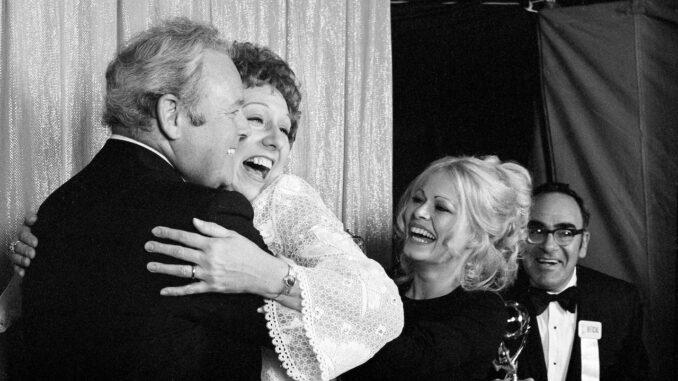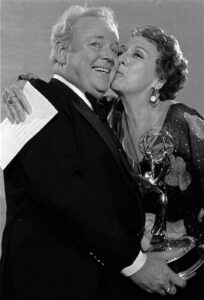
The legendary singer, Sammy Davis Jr., had left his briefcase in Archie Bunker’s cab, drops by the Bunker house to retrieve it, and Archie is initially thrilled. “Mr. Davis, there’s my daughter, Gloria, standing over there,” he said, “and her husband, Mike.” Gloria is standing next to Lionel Jefferson, a young Black man and neighbor. Davis shakes Lionel’s hand, mischievously presuming he is Gloria’s husband, shocking Archie, who shouts in the midst of shrieking audience laughter, “No, no.” After a painful pause he explained, “This is only Lionel. He lives next door. My daughter’s married to the white guy over here.”
“All in the Family” was, of course, the brainchild of Norman Lear, who died on Dec. 5 after a pathbreaking career that changed television by introducing previously taboo topics in ways that could both educate and entertain.
Looking back at “All in the Family” more than 50 years later, we gain insights about what it did for America back then and its salutary implications for today.
Initially, critics worried that the show would strengthen rather than mend pre-existing prejudices, calling attention to a famous study that found adolescents high in admiring Archie while those low in admiring Mike.
But a careful look at the research suggests that critics missed some of the program’s more subtle crossover effects and ability to engender empathy.

While nearly four in 10 adolescents highly in admired the lovable bigot Archie more than Mike (his irascibly liberal son-in-law), close to a fourth of low-prejudiced teenagers acknowledged that they, too, admired Archie more than Mike. Equal numbers of both groups thought Mike made better sense. This suggests that many viewers were willing to put aside their biases and see things from the other side’s point of view.
In fact, the show got people of different political stripes to talk about their differences. “The country either sided with Archie or sided with Mike, and that made for great discussions,” said Rob Reiner, who famously played Mike (aka “Meathead”).
“We watched Archie as a family and I’ll never forget the discussions we had after the show,” people told Lear over the years.
For what the show did was to humanize the characters – to depict the characters not as cartoon caricatures of a political ideology, but as emotionally complex and even lovable. “I’ve never known a bigot who didn’t have anything ending,” Lear said.
And that ability to humanize our adversaries is exactly what we need today, if we want to bridge the polarization that is far greater now than it was in the early 1970s. As we begin 2024, with the nation’s political divisions on full display, I think we desperately need a contemporary rendition of “All in the Family” that includes a dogmatic 2020 election-denying Donald Trump voter, a rigidly woke leftist, and a far- gone QAnon true believer in the style of the old Mary Hartman TV character, also a Lear creation.
Unfortunately, this reimagined “All in the Family” project faces obstacles.
First, people take more offense at political satire than they did 50 years ago; a Trumper’s political or ethnic slurs would be viewed as micro-aggression rather than comedic reflections of his own limitations.
Secondly, we no longer live in an age of appointment television, where some 45 million people watch “All in the Family” every week, as often as a family. Alas, social media, where so many young people prefer to spend their time, often exerts exactly the opposite effect of a reimagined “All in The Family,” calcifying, rather than reducing, partisan antagonism.
So, here we are, as a new year begins, with grand electoral hopes, but trapped in our partisan moment, unable to harness humor to create a new political path.
